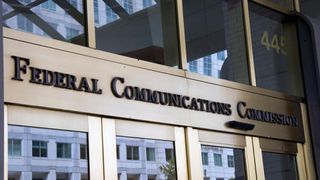FCC Votes to Open C-Band for Wireless Broadband

The FCC has unanimously voted to find ways to open up the C-band spectrum (3.7-4.2 Ghz) -- either all of the proposed 500 Mhz or some portion of it -- for terrestrial wireless use.
Those ways could include an incentive or capacity auction, a market mechanism where incumbents voluntarily strike deals to reduce their footprint, or some other means.
The C-band is currently used for satellite delivery of cable and broadcast network programming to cable head-ends, TVs and radio stations. The FCC wants to open it up to wireless broadband to help close the digital divide and promote 5G, both prime directives for the commission.
The combination order and notice of proposed rulemaking (NPRM) would do four things:
- Collect information from those broadcast and cable operators to help guide the repurposing/sharing;
- Propose to add a mobile allocation to the entire 500 Mhz, which is currently designated for nonexclusive fixed-satellite use;
- Seek comment on allowing shared fixed-use in a portion of the band; and
- Seek comment on service and technical rules.
Related: FCC Opens Door to C-Band Auction

FCC chair Ajit Pai, a big fan of movie and song references, likened the FCC's search for more spectrum to the observation in Jaws once the size of the shark became obvious: "We're going to need a bigger boat."
Pai said the item was another recognition that the U.S. needs a bigger spectrum pipeline.
Multichannel Newsletter
The smarter way to stay on top of the multichannel video marketplace. Sign up below.
Commissioner Jessica Rosenworcel agreed, but said the FCC is playing catch-up in the mid-band spectrum clearing space, and needed to be less opaque about what spectrum it is freeing up and when.
"With today’s rulemaking and order we are doing something about it," she said. "We explore a variety of mechanisms for clearing the 3.7-4.2 GHz band for 5G use. And if we make headway here, we can start to reclaim lost leadership in spectrum that is critical for success in 5G networks."
Commissioner Michael O'Rielly supported the item, but had some issues with it, including taking an auction route. He said it made more sense to let market players resolve the issue among themselves rather than through FCC mandates and mandatory clearing.
He also said he does not think the proposed 100 MHz is enough to free up, saying it will need to be more like 200-300 Mhz for exclusive wireless use.
“The broadcast, cable and satellite incumbents have made it clear that only a portion of C-band can be cleared for exclusive mobile use any time soon," said Michael Calabrese, director of New America's Wireless Future Program. "It’s therefore critical that the NPRM also proposes that fixed wireless providers be allowed to coordinate shared use of other portions of the band as a way to narrow the rural broadband gap and enhance competition for high-capacity internet access.”
AT&T EVP Joan Marsh said: “The FCC’s ongoing efforts to make additional spectrum available to support next-generation 5G services is essential. The 3.7-4.2 GHz band could play a key role in providing the broad coverage capabilities necessary to bring the promise of 5G technologies to consumers across the U.S. The Commission’s order and proposed rulemaking strikes the right balance between the effort to reallocate spectrum to bring robust 5G services to consumers and ensuring that essential existing spectrum use cases are preserved. In addition, we appreciate the Commission’s continuing efforts to reform and harmonize its cellular rules to eliminate outdated and duplicative regulations so carriers can focus on investing in advanced wireless services.”
Contributing editor John Eggerton has been an editor and/or writer on media regulation, legislation and policy for over four decades, including covering the FCC, FTC, Congress, the major media trade associations, and the federal courts. In addition to Multichannel News and Broadcasting + Cable, his work has appeared in Radio World, TV Technology, TV Fax, This Week in Consumer Electronics, Variety and the Encyclopedia Britannica.

